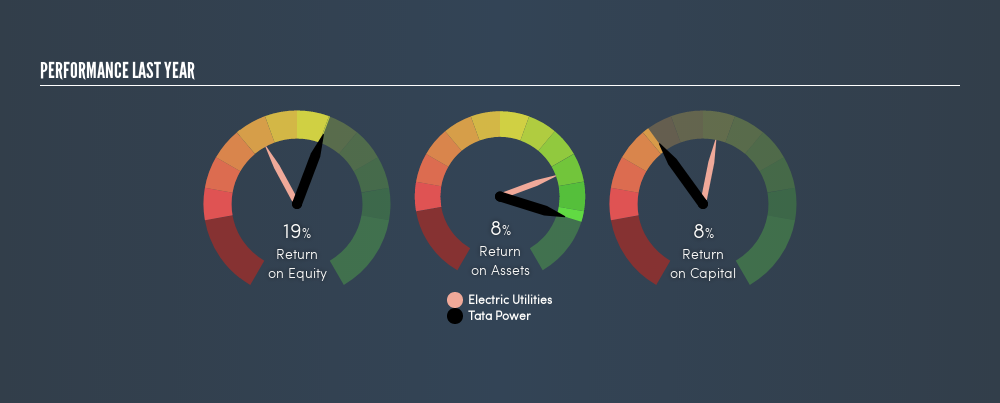- India
- /
- Electric Utilities
- /
- NSEI:TATAPOWER
Are The Tata Power Company Limited’s (NSE:TATAPOWER) Returns Worth Your While?

Today we'll evaluate The Tata Power Company Limited (NSE:TATAPOWER) to determine whether it could have potential as an investment idea. In particular, we'll consider its Return On Capital Employed (ROCE), as that can give us insight into how profitably the company is able to employ capital in its business.
Firstly, we'll go over how we calculate ROCE. Next, we'll compare it to others in its industry. Last but not least, we'll look at what impact its current liabilities have on its ROCE.
Return On Capital Employed (ROCE): What is it?
ROCE is a measure of a company's yearly pre-tax profit (its return), relative to the capital employed in the business. In general, businesses with a higher ROCE are usually better quality. In brief, it is a useful tool, but it is not without drawbacks. Renowned investment researcher Michael Mauboussin has suggested that a high ROCE can indicate that 'one dollar invested in the company generates value of more than one dollar'.
So, How Do We Calculate ROCE?
Analysts use this formula to calculate return on capital employed:
Return on Capital Employed = Earnings Before Interest and Tax (EBIT) ÷ (Total Assets - Current Liabilities)
Or for Tata Power:
0.077 = ₹42b ÷ (₹848b - ₹306b) (Based on the trailing twelve months to December 2018.)
Therefore, Tata Power has an ROCE of 7.7%.
Check out our latest analysis for Tata Power
Does Tata Power Have A Good ROCE?
When making comparisons between similar businesses, investors may find ROCE useful. It appears that Tata Power's ROCE is fairly close to the Electric Utilities industry average of 8.3%. Putting aside Tata Power's performance relative to its industry, its ROCE in absolute terms is poor - considering the risk of owning stocks compared to government bonds. There are potentially more appealing investments elsewhere.
Tata Power's current ROCE of 7.7% is lower than its ROCE in the past, which was 13%, 3 years ago. This makes us wonder if the business is facing new challenges.

It is important to remember that ROCE shows past performance, and is not necessarily predictive. ROCE can be misleading for companies in cyclical industries, with returns looking impressive during the boom times, but very weak during the busts. This is because ROCE only looks at one year, instead of considering returns across a whole cycle. Since the future is so important for investors, you should check out our freereport on analyst forecasts for Tata Power.
Tata Power's Current Liabilities And Their Impact On Its ROCE
Liabilities, such as supplier bills and bank overdrafts, are referred to as current liabilities if they need to be paid within 12 months. Due to the way the ROCE equation works, having large bills due in the near term can make it look as though a company has less capital employed, and thus a higher ROCE than usual. To counter this, investors can check if a company has high current liabilities relative to total assets.
Tata Power has total assets of ₹848b and current liabilities of ₹306b. Therefore its current liabilities are equivalent to approximately 36% of its total assets. In light of sufficient current liabilities to noticeably boost the ROCE, Tata Power's ROCE is concerning.
What We Can Learn From Tata Power's ROCE
There are likely better investments out there. But note: Tata Power may not be the best stock to buy. So take a peek at this freelist of interesting companies with strong recent earnings growth (and a P/E ratio below 20).
For those who like to find winning investments this freelist of growing companies with recent insider purchasing, could be just the ticket.
We aim to bring you long-term focused research analysis driven by fundamental data. Note that our analysis may not factor in the latest price-sensitive company announcements or qualitative material.
If you spot an error that warrants correction, please contact the editor at editorial-team@simplywallst.com. This article by Simply Wall St is general in nature. It does not constitute a recommendation to buy or sell any stock, and does not take account of your objectives, or your financial situation. Simply Wall St has no position in the stocks mentioned. Thank you for reading.
About NSEI:TATAPOWER
Tata Power
Engages in the generation, transmission, distribution, and trading of electricity in India and internationally.
Average dividend payer with acceptable track record.


